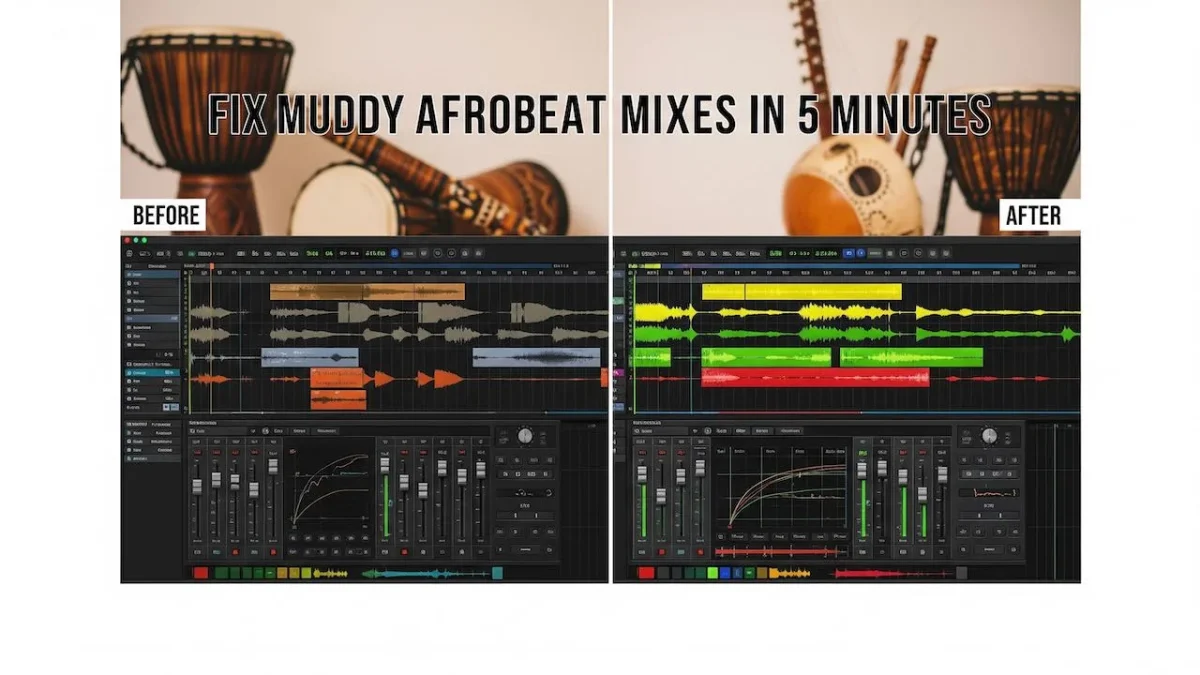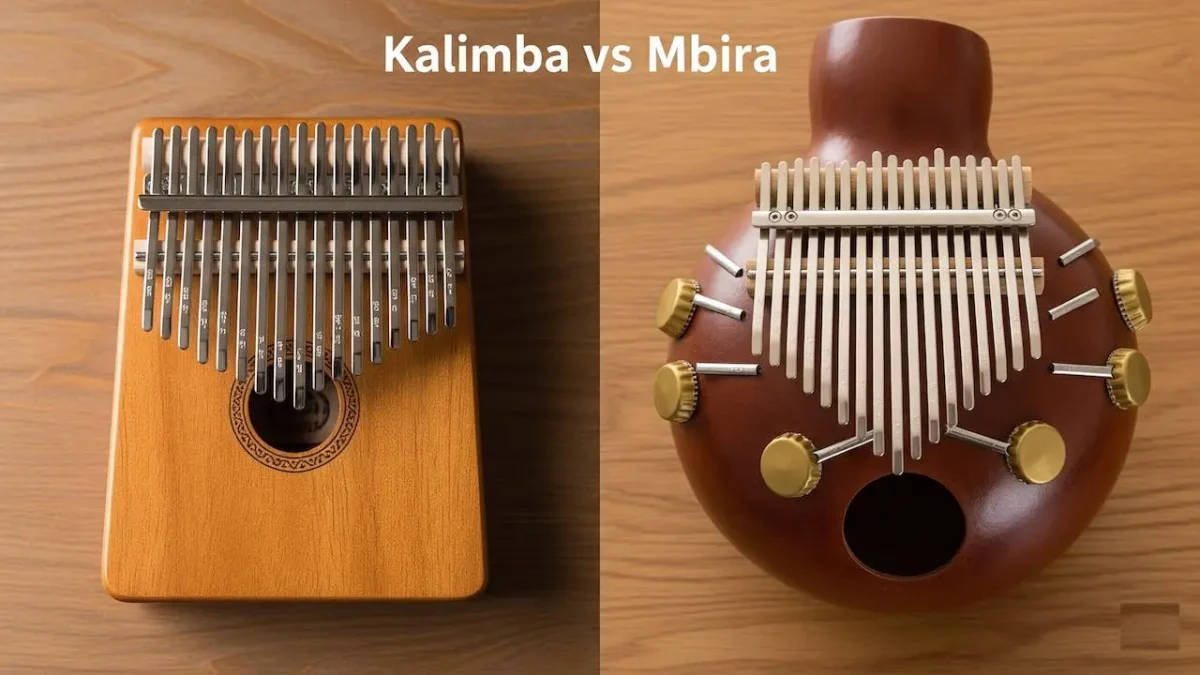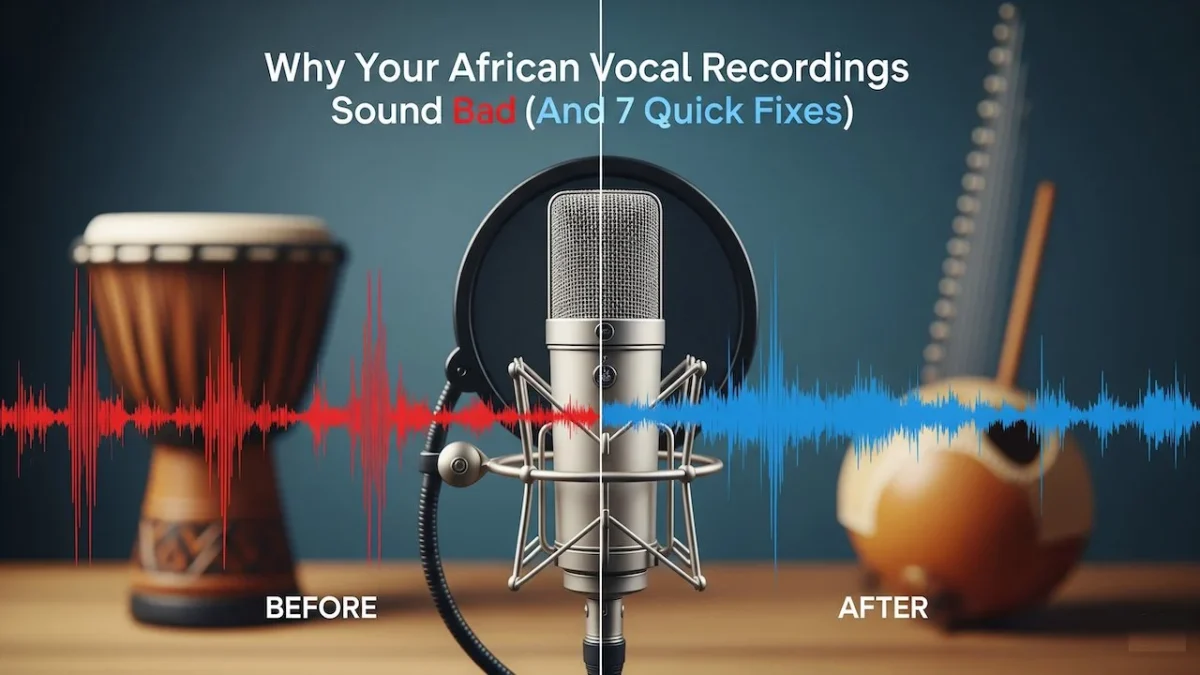
Fix Muddy Afrobeat Mixes in 5 Minutes (Step-by-Step Guide)
Muddy Afrobeat mixes happen when low-mid frequencies between 150Hz and 400Hz clash, creating unclear bass and percussion sounds. Most producers fix this by cutting problem frequencies, separating bass elements, and applying strategic EQ techniques that restore clarity without losing the genre’s signature warmth.
Afrobeat music relies heavily on complex percussion patterns, deep bass lines, and layered rhythmic elements. When these frequencies compete for the same sonic space, your mix becomes unclear and loses its punch. This guide shows you exactly how to identify and fix these issues quickly.
Why Afrobeat Mixes Get Muddy (The Root Causes)
Frequency masking occurs when multiple instruments occupy the same frequency range simultaneously. Mud lives down between 2-400 hz, and Afrobeat’s signature elements like kick drums, bass guitars, and lower percussion all compete in this space.
The main culprits include overlapping bass frequencies, excessive low-mid buildup from multiple percussion layers, and poor stereo imaging that stacks instruments on top of each other. Additionally, effects like reverb and delay sparingly. These effects add depth but can also muddy up the mix if overdone.
Step 1: Identify Problem Areas Using Spectrum Analysis
Load a spectrum analyzer on your master bus to visualize frequency buildup. Look for excessive energy between 150Hz and 400Hz where most muddiness occurs. Use your DAW’s built-in analyzer or plugins like Voxengo SPAN to see these problem frequencies.
Solo individual tracks while watching the analyzer. Notice which instruments contribute most to the low-mid buildup. Common problem sources include bass guitar fundamentals, kick drum resonance, and lower tom frequencies that stack up during complex polyrhythmic sections.
Step 2: Clean Up Bass and Kick Drum Separation
Create space between your kick drum and bass guitar using complementary EQ cuts and boosts. It’s important to know that I’m making a judgment call: do I cut the kick or sculpt the bass to make room for each element.
Try these specific frequency adjustments:
- Cut bass guitar around 60-80Hz if kick drum needs more sub presence
- Boost kick drum at 100-120Hz while cutting bass at the same frequency
- Use high-pass filters on bass starting around 40Hz to remove unnecessary sub frequencies
- Apply gentle cuts to bass around 200-300Hz to reduce muddiness
| Instrument | Cut Frequency | Boost Frequency | Purpose |
|---|---|---|---|
| Kick Drum | 300-400Hz | 60-80Hz, 2-4kHz | Remove mud, add punch |
| Bass Guitar | 200-300Hz | 80-120Hz | Clarity and definition |
| Snare | 400-600Hz | 200Hz, 5kHz | Body and crack |
Step 3: Address Percussion Layer Conflicts
Use high-pass filtering on percussion elements that don’t need low-end information. Apply filters starting around 80-120Hz on shakers, hi-hats, and auxiliary percussion to prevent low-frequency buildup.
Pan similar percussion elements to different sides of the stereo field. For example, place congas on the left while keeping bongos centered or slightly right. This technique prevents frequency masking while maintaining the authentic feel of traditional Afrobeat arrangements.
Specific Percussion EQ Guidelines
Each percussion element needs its own frequency pocket. Cut overlapping frequencies between talking drums and congas around 200-400Hz. if you hear that bassline sounds muddy, that’s going to be somewhere in 150Hz – 500Hz range, and the same principle applies to percussion layers.
Step 4: Apply Strategic Mid-Side EQ Processing
Use mid-side EQ to clean up the center channel while preserving stereo width. create separation and clarity by cutting or attenuating low frequencies from the side channel to focus bass elements in the center.
Process the center channel by cutting problematic frequencies around 250-350Hz. Leave the sides wider for percussion and melodic elements. This approach maintains the stereo image while reducing muddiness in the most problematic frequency range.
Step 5: Final Polish with Multiband Compression
Apply gentle multiband compression to control dynamic frequency buildup. Set a band covering 150-400Hz with a slow attack and medium release. Use ratios between 2:1 and 3:1 to catch frequency spikes without over-processing.
Monitor the gain reduction meter to ensure you’re not compressing more than 2-3dB consistently. The goal is transparent control, not obvious pumping that would destroy the natural groove of Afrobeat music.
| Frequency Band | Ratio | Attack | Release | Threshold |
|---|---|---|---|---|
| 150-400Hz | 2.5:1 | 10ms | 100ms | -12dB |
| 400Hz-2kHz | 2:1 | 5ms | 80ms | -8dB |
Common Mistakes to Avoid When Fixing Muddy Mixes
Don’t cut too aggressively in the low-mids or you’ll lose the warmth that makes Afrobeat special. Using a gentle bell curve and dipping by just 1 or 2dB can make a big difference rather than harsh cuts that remove musical content.
Avoid over-processing with multiple EQs on the same track. Instead, make decisive cuts and trust your ears. Also, resist the urge to boost frequencies to compensate for cuts elsewhere, as this often creates more problems than it solves.
Reverb and Effects Considerations
Apply reverb carefully to avoid adding more muddiness. Use very little amount of reverb on Lead Vocals when mixing Afrobeat music. The mix amount from 1-100% should be around 5-10% to maintain clarity while preserving spatial depth.
Testing Your Mix for Clarity
Reference your mix on multiple playback systems to confirm muddiness removal. Check your mix on car speakers, phone speakers, and studio monitors. If the bass and kick drum remain distinct across all systems, you’ve successfully addressed the muddiness.
Use reference tracks from professional Afrobeat recordings. Compare frequency balance and clarity between your mix and established songs in the genre. This comparison helps identify remaining problem areas that need attention.
People Also Ask
Muddiness typically occurs between 150Hz and 400Hz where bass, kick drums, and lower percussion frequencies overlap. This range contains the fundamental and harmonic content of most rhythmic elements in Afrobeat music.
Cut competing frequencies between bass and kick using complementary EQ. If your kick needs presence around 80Hz, cut the bass at that frequency and boost it elsewhere, like 120Hz or 200Hz for definition.
Yes, apply high-pass filters starting around 80-120Hz on auxiliary percussion like shakers and bells. This prevents unnecessary low-frequency buildup while preserving the authentic character of each instrument.
Use spectrum analysis combined with critical listening on multiple playback systems. Visual feedback helps identify problem frequencies while varied speakers reveal how your mix translates across different listening environments.
Start with gentle cuts of 1-3dB using wide Q settings. Aggressive cuts can remove musical content and make your mix sound thin. Multiple small adjustments work better than single large cuts.
Multiband compression controls dynamic frequency buildup effectively. Use gentle ratios around 2-3:1 in the problematic frequency range to catch spikes without destroying the natural groove and dynamics.



